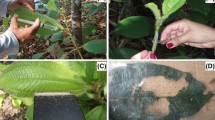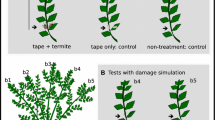Abstract
Although associations between myrmecophytes and their plant ants are recognized as a particularly effective form of protective mutualism, their functioning remains incompletely understood. This field study examined the ant-plant Hirtella physophora and its obligate ant associate Allomerus decemarticulatus. We formulated two hypotheses on the highly specific nature of this association: (1) Ant presence should be correlated with a marked reduction in the amount of herbivory on the plant foliage; (2) ant activity should be consistent with the "optimal defense" theory predicting that the most vulnerable and valuable parts of the plant are the best defended. We validated the first hypothesis by demonstrating that for ant-excluded plants, expanding leaves, but also newly matured ones in the long term, suffered significantly more herbivore damage than ant-inhabited plants. We showed that A. decemarticulatus workers represent both constitutive and inducible defenses for their host, by patrolling its foliage and rapidly recruiting nestmates to foliar wounds. On examining how these activities change according to the leaves’ developmental stage, we found that the number of patrolling ants dramatically decreased as the leaves matured, while leaf wounds induced ant recruitment regardless of the leaf’s age. The resulting level of these indirect defenses was roughly proportional to leaf vulnerability and value during its development, thus validating our second hypothesis predicting optimal protection. This led us to discuss the factors influencing ant activity on the plant’s surface. Our study emphasizes the importance of studying both the constitutive and inducible components of indirect defense when evaluating its efficacy and optimality.


Similar content being viewed by others
References
Agrawal AA (1998) Leaf damage and associated cues induce aggressive ant recruitment in a neotropical ant-plant. Ecology 79:2100–2112
Agrawal AA, Dubin-Thaler BJ (1999) Induced responses to herbivory in the Neotropical ant–plant association between Azteca ants and Cecropia trees: response of ants to potential inducing cues. Behav Ecol Sociobiol 45:47–54
Amsellem L, McKey D (2006) Integrating phenological, chemical and biotic defences in ant–plant protection mutualisms: a case study of two myrmecophyte lineages. Chemoecology 16:223–234
Beattie AJ, Hughes L (2002) Ant-plant interactions. In: Herrera CM, Pellmyr O (eds) Plant-animal interactions. Blackwell, Oxford, pp 211–235
Benson WW (1985) Amazon ant-plants. In: Prance GT, Lovejoy TE (eds) Key environments. Amazonia. Pergamon, Oxford, pp 239–266
Brouat C, McKey D, Bessière JM, Pascal L, Hossaert-McKey M (2000) Leaf volatile compounds and the distribution of ant patrolling in an ant-plant protection mutualism: preliminary results on Leonardoxa (Fabaceae: Caesalpinioideae) and Petalomyrmex (Formicidae: Formicinae). Acta Oecol 21:349–357
Bruna EM, Lapola DM, Vasconcelos HL (2004) Interspecific variation in the defensive responses of obligate plant-ants: experimental tests and consequences for herbivory. Oecologia 138:558–565
Christianini AV, Machado G (2004) Induced biotic responses to herbivory and associated cues in the Amazonian ant-plant Maieta poeppigii. Entomol Exp Appl 112:81–88
Coley PD (1983) Herbivory and defensive characteristics of tree species in a lowland tropical forest. Ecol Monogr 53:209–234
Coley PD, Barone JA (1996) Herbivory and plant defenses in tropical forests. Annu Rev Ecol Syst 27:305–335
Davidson DW, McKey D (1993) The evolutionary ecology of symbiotic ant–plant relationships. J Hym Res 2:13–83
Debout G, Schatz B, McKey D (2005) Behavioural traits mediating effects of two plant-ants on their specific myrmecophyte host. Insect Soc 52:205–211
Dejean A, Solano PJ, Belin-Depoux M, Cerdan P, Corbara B (2001) Predatory behavior of patrolling Allomerus decemarticulatus workers (Formicidae; Myrmicinae) on their host plant. Sociobiology 37:571–578
Dejean A, Solano PJ, Ayroles J, Corbara B, Orivel J (2005) Arboreal ants build traps to capture prey. Nature 434:973
Dejean A, Delabie J, Cerdan P, Gibernau M, Corbara B (2006) Are myrmecophytes always better protected against herbivores than other plants? Biol J Linn Soc 89:91–98
Edwards DP, Arauco R, Hassall M, Sutherland WJ, Chamberlain K, Wadhams LJ, Yu DW (2007) Protection in an ant–plant mutualism: an adaptation or a sensory trap ? Anim Behav 74:377–385
Frederickson ME (2005) Ant species confer different partner benefits on two neotropical myrmecophytes. Oecologia 143:387–395
Gaume L, McKey D (1999) An ant–plant mutualism and its host-specific parasite: activity rhythms, young leaf patrolling, and effects on herbivores of two specialist plant-ant inhabiting the same mymecophyte. Oikos 84:130–144
Heil M, McKey D (2003) Protective ant–plant interactions as model systems in ecological and evolutionary research. Annu Rev Ecol Evol Syst 34:425–453
Heil M, Fiala B, Maschwitz U, Linsenmair KE (2001) On benefits of indirect defence: short- and long-term studies of antiherbivore protection via mutualistic ants. Oecologia 126:395–403
Heil M, Delsinne T, Hilpert A, Schürkens S, Andary C, Linsenmair KE, Sousa M, McKey D (2002) Reduced chemical defense in ant-plants? A critical re-evaluation of a widely accepted hypothesis. Oikos 99:457–468
Heil M, Feil D, Hilpert A, Linsenmair K (2004) Spatiotemporal patterns in indirect defence of a South-East Asian ant-plant support the optimal defence hypothesis. J Trop Ecol 20:573–580
Heil M, Rattke J, Boland W (2005) Postsecretory hydrolysis of nectar and specialization in ant/plant mutualism. Science 308:560–563
Izzo TJ, Vasconcelos HL (2002) Cheating the cheater: domatia loss minimizes the effects of ant castration in an Amazonian ant-plant. Oecologia 133:200–205
Karabourniotis G, Fasseas C (1996) The dense indumentum with its polyphenol content may replace the protective role of the epidermis in some young xeromorphic leaves. Can J Bot 74:347–351
Lapola DM, Bruna EM, Vasconcelos HL (2003) Contrasting responses to induction cues by ants inhabiting Maieta guianensis (Melastomataceae). Biotropica 35:295–300
Leroy C, Jauneau A, Quilichini A, Dejean A, Orivel J (2008) Comparison between the anatomical and morphological structure of leaf blades and foliar domatia in the ant-plant Hirtella physophora (Chrysobalanaceae). Ann Bot 101:501–507
McKey D (1974) Adaptive patterns in alkaloid physiology. Am Nat 108:305–320
Raine NE, Gammans N, Macfadyen IJ, Scrivner GK, Stone GN (2004) Guards and thieves: antagonistic interactions between two ant species coexisting on the same ant–plant. Ecol Entomol 29:345–352
Rhoades DF (1979) Evolution of plant chemical defense against herbivores. In: Rosenthal GA, Janzen DH (eds) Herbivores: their interaction with secondary plant metabolites. Academic, New York/London, pp 4–53
Rico-Gray V, Oliveira P (2007) The ecology and evolution of ant–plant interactions. The University of Chicago, Chicago and London
Romero GQ, Izzo TJ (2004) Leaf damage induces ant recruitment in the Amazonian ant-plant Hirtella myrmecophila. J Trop Ecol 20:675–682
Rostás M, Eggert K (2008) Ontogenetic and spatio-temporal patterns of induced volatiles in Glycine max in the light of the optimal defence hypothesis. Chemoecology 18:29–38
Solano PJ, Durou S, Corbara B, Quilichini A, Cerdan P, Belin-Depoux M, Delabie JHC, Dejean A (2003) Myrmecophytes of the understory of French Guianian rainforests: their distribution and their associated ants. Sociobiology 41:605–614
Tollrian R, Harvell CD (1999) The ecology and evolution of inducible defenses. Princeton University Press, Princeton
Valkama E, Salminen J-H, Koricheva J, Pihlaja K (2004) Changes in leaf trichomes and epicuticular flavonoids during leaf development in three birch taxa. Ann Bot 94:233–242
Acknowledgments
We are grateful to Andrea Dejean for proofreading the manuscript, to Doyle McKey, Douglas Yu and two anonymous referees for their in-depth reading and relevant remarks, to Michaël Negrini and Jean-Michel Martin for their help in the field, and to the Laboratoire Environnement de Petit Saut for logistical support. This work was provided support by the Programme Amazonie of the CNRS-Guyane to AD and a research program of the French Agence Nationale de la Recherche (research agreement no. ANR-06-JCJC-0109-01) to JO.
Author information
Authors and Affiliations
Corresponding author
Rights and permissions
About this article
Cite this article
Grangier, J., Dejean, A., Malé, PJ.G. et al. Indirect defense in a highly specific ant–plant mutualism. Naturwissenschaften 95, 909–916 (2008). https://doi.org/10.1007/s00114-008-0398-4
Received:
Revised:
Accepted:
Published:
Issue Date:
DOI: https://doi.org/10.1007/s00114-008-0398-4




